Financial Accounting and Reporting: Analysis and Reporting for EL Ltd
VerifiedAdded on 2020/02/03
|21
|5486
|59
Report
AI Summary
This report provides a comprehensive analysis of financial accounting and reporting practices for EL Ltd, a domestic electrical services provider. The report begins by identifying various users of financial information, such as managers, employees, suppliers, the government, and customers, along with their respective needs. It then explores the legal and regulatory influences on financial statements, including the role of the Financial Reporting Council (FRC) and relevant legislation like the Companies Act 2006. The report assesses the implications of these regulations for stakeholders and how accounting standards address different laws. Furthermore, it includes the preparation of financial statements, starting with an unadjusted trial balance and progressing to adjusted trial balances, income statements, and balance sheets. The report also covers the preparation of financial statements from incomplete records and the calculation and interpretation of accounting ratios. The report concludes by summarizing the information needs of different user groups and provides a detailed financial analysis of EL Ltd's performance, incorporating key accounting principles and practices.
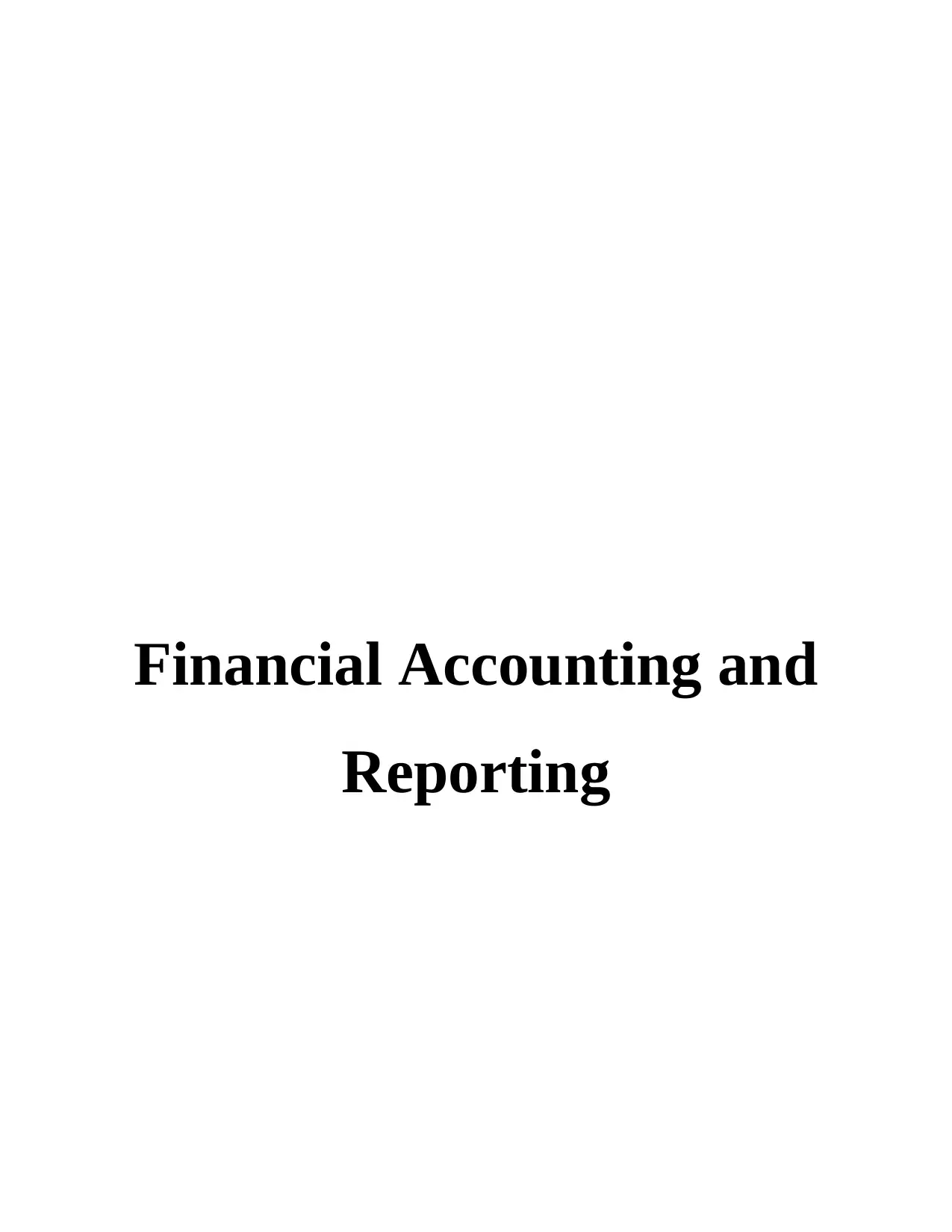
Financial Accounting and
Reporting
Reporting
Paraphrase This Document
Need a fresh take? Get an instant paraphrase of this document with our AI Paraphraser
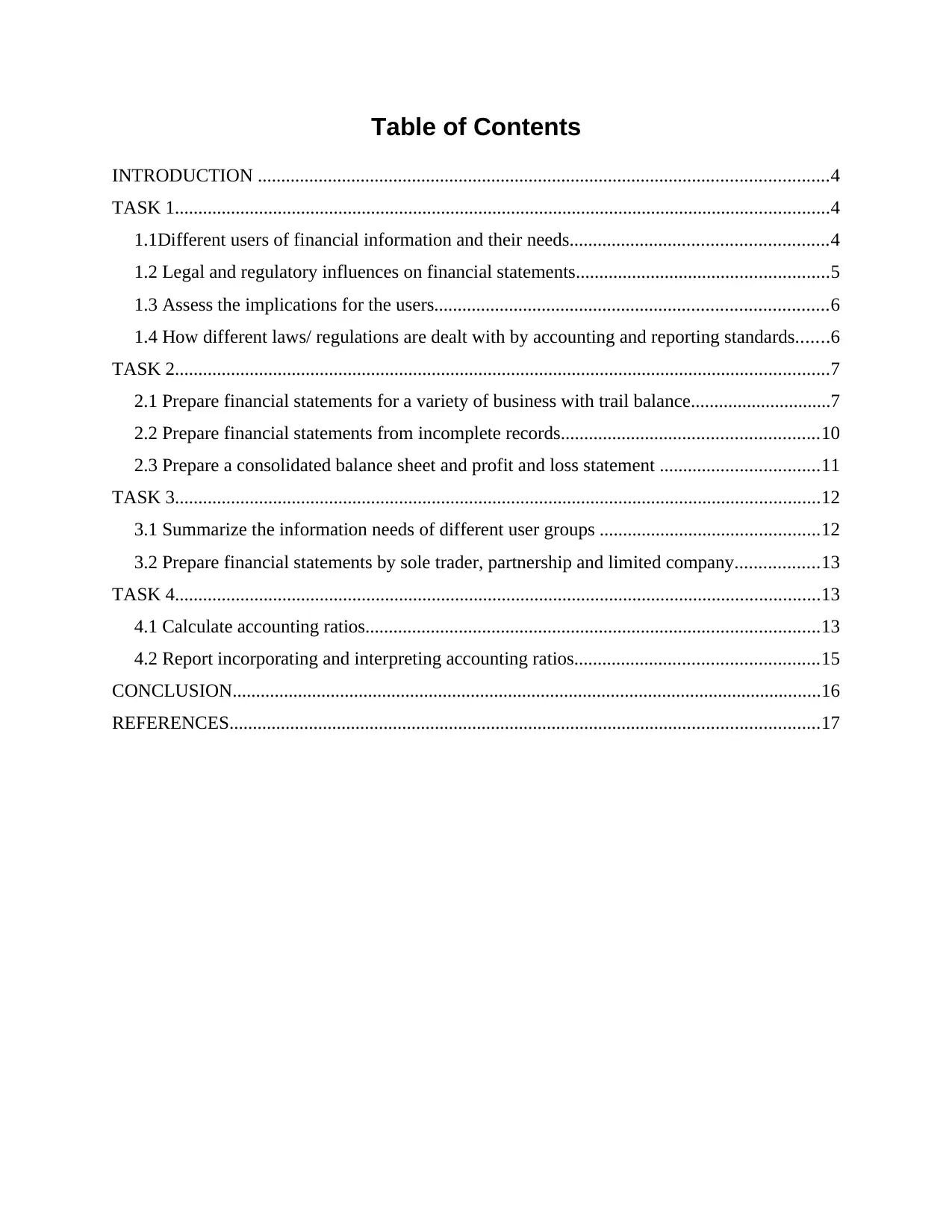
Table of Contents
INTRODUCTION ..........................................................................................................................4
TASK 1............................................................................................................................................4
1.1Different users of financial information and their needs.......................................................4
1.2 Legal and regulatory influences on financial statements......................................................5
1.3 Assess the implications for the users....................................................................................6
1.4 How different laws/ regulations are dealt with by accounting and reporting standards.......6
TASK 2............................................................................................................................................7
2.1 Prepare financial statements for a variety of business with trail balance..............................7
2.2 Prepare financial statements from incomplete records.......................................................10
2.3 Prepare a consolidated balance sheet and profit and loss statement ..................................11
TASK 3..........................................................................................................................................12
3.1 Summarize the information needs of different user groups ...............................................12
3.2 Prepare financial statements by sole trader, partnership and limited company..................13
TASK 4..........................................................................................................................................13
4.1 Calculate accounting ratios.................................................................................................13
4.2 Report incorporating and interpreting accounting ratios....................................................15
CONCLUSION..............................................................................................................................16
REFERENCES..............................................................................................................................17
INTRODUCTION ..........................................................................................................................4
TASK 1............................................................................................................................................4
1.1Different users of financial information and their needs.......................................................4
1.2 Legal and regulatory influences on financial statements......................................................5
1.3 Assess the implications for the users....................................................................................6
1.4 How different laws/ regulations are dealt with by accounting and reporting standards.......6
TASK 2............................................................................................................................................7
2.1 Prepare financial statements for a variety of business with trail balance..............................7
2.2 Prepare financial statements from incomplete records.......................................................10
2.3 Prepare a consolidated balance sheet and profit and loss statement ..................................11
TASK 3..........................................................................................................................................12
3.1 Summarize the information needs of different user groups ...............................................12
3.2 Prepare financial statements by sole trader, partnership and limited company..................13
TASK 4..........................................................................................................................................13
4.1 Calculate accounting ratios.................................................................................................13
4.2 Report incorporating and interpreting accounting ratios....................................................15
CONCLUSION..............................................................................................................................16
REFERENCES..............................................................................................................................17

⊘ This is a preview!⊘
Do you want full access?
Subscribe today to unlock all pages.

Trusted by 1+ million students worldwide
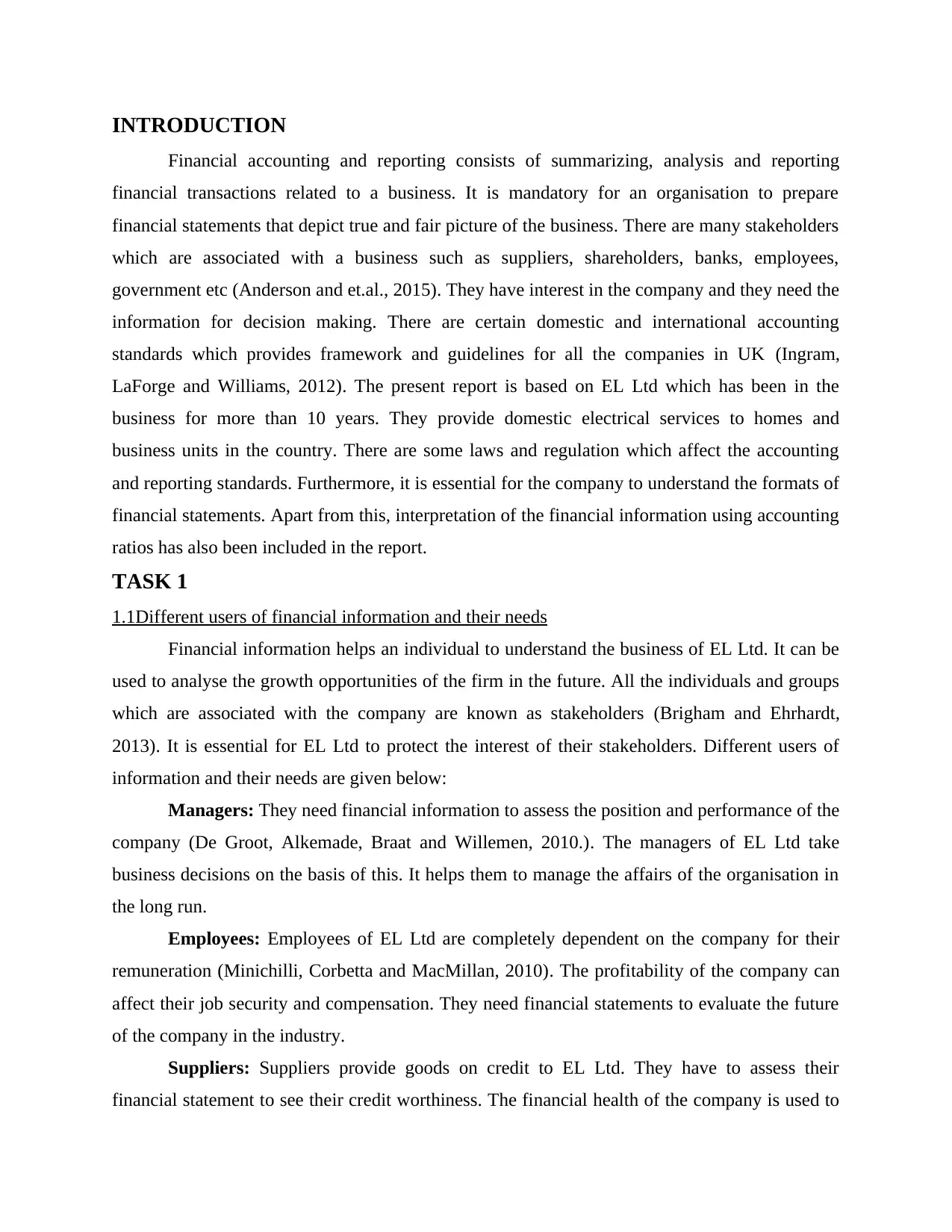
INTRODUCTION
Financial accounting and reporting consists of summarizing, analysis and reporting
financial transactions related to a business. It is mandatory for an organisation to prepare
financial statements that depict true and fair picture of the business. There are many stakeholders
which are associated with a business such as suppliers, shareholders, banks, employees,
government etc (Anderson and et.al., 2015). They have interest in the company and they need the
information for decision making. There are certain domestic and international accounting
standards which provides framework and guidelines for all the companies in UK (Ingram,
LaForge and Williams, 2012). The present report is based on EL Ltd which has been in the
business for more than 10 years. They provide domestic electrical services to homes and
business units in the country. There are some laws and regulation which affect the accounting
and reporting standards. Furthermore, it is essential for the company to understand the formats of
financial statements. Apart from this, interpretation of the financial information using accounting
ratios has also been included in the report.
TASK 1
1.1Different users of financial information and their needs
Financial information helps an individual to understand the business of EL Ltd. It can be
used to analyse the growth opportunities of the firm in the future. All the individuals and groups
which are associated with the company are known as stakeholders (Brigham and Ehrhardt,
2013). It is essential for EL Ltd to protect the interest of their stakeholders. Different users of
information and their needs are given below:
Managers: They need financial information to assess the position and performance of the
company (De Groot, Alkemade, Braat and Willemen, 2010.). The managers of EL Ltd take
business decisions on the basis of this. It helps them to manage the affairs of the organisation in
the long run.
Employees: Employees of EL Ltd are completely dependent on the company for their
remuneration (Minichilli, Corbetta and MacMillan, 2010). The profitability of the company can
affect their job security and compensation. They need financial statements to evaluate the future
of the company in the industry.
Suppliers: Suppliers provide goods on credit to EL Ltd. They have to assess their
financial statement to see their credit worthiness. The financial health of the company is used to
Financial accounting and reporting consists of summarizing, analysis and reporting
financial transactions related to a business. It is mandatory for an organisation to prepare
financial statements that depict true and fair picture of the business. There are many stakeholders
which are associated with a business such as suppliers, shareholders, banks, employees,
government etc (Anderson and et.al., 2015). They have interest in the company and they need the
information for decision making. There are certain domestic and international accounting
standards which provides framework and guidelines for all the companies in UK (Ingram,
LaForge and Williams, 2012). The present report is based on EL Ltd which has been in the
business for more than 10 years. They provide domestic electrical services to homes and
business units in the country. There are some laws and regulation which affect the accounting
and reporting standards. Furthermore, it is essential for the company to understand the formats of
financial statements. Apart from this, interpretation of the financial information using accounting
ratios has also been included in the report.
TASK 1
1.1Different users of financial information and their needs
Financial information helps an individual to understand the business of EL Ltd. It can be
used to analyse the growth opportunities of the firm in the future. All the individuals and groups
which are associated with the company are known as stakeholders (Brigham and Ehrhardt,
2013). It is essential for EL Ltd to protect the interest of their stakeholders. Different users of
information and their needs are given below:
Managers: They need financial information to assess the position and performance of the
company (De Groot, Alkemade, Braat and Willemen, 2010.). The managers of EL Ltd take
business decisions on the basis of this. It helps them to manage the affairs of the organisation in
the long run.
Employees: Employees of EL Ltd are completely dependent on the company for their
remuneration (Minichilli, Corbetta and MacMillan, 2010). The profitability of the company can
affect their job security and compensation. They need financial statements to evaluate the future
of the company in the industry.
Suppliers: Suppliers provide goods on credit to EL Ltd. They have to assess their
financial statement to see their credit worthiness. The financial health of the company is used to
Paraphrase This Document
Need a fresh take? Get an instant paraphrase of this document with our AI Paraphraser
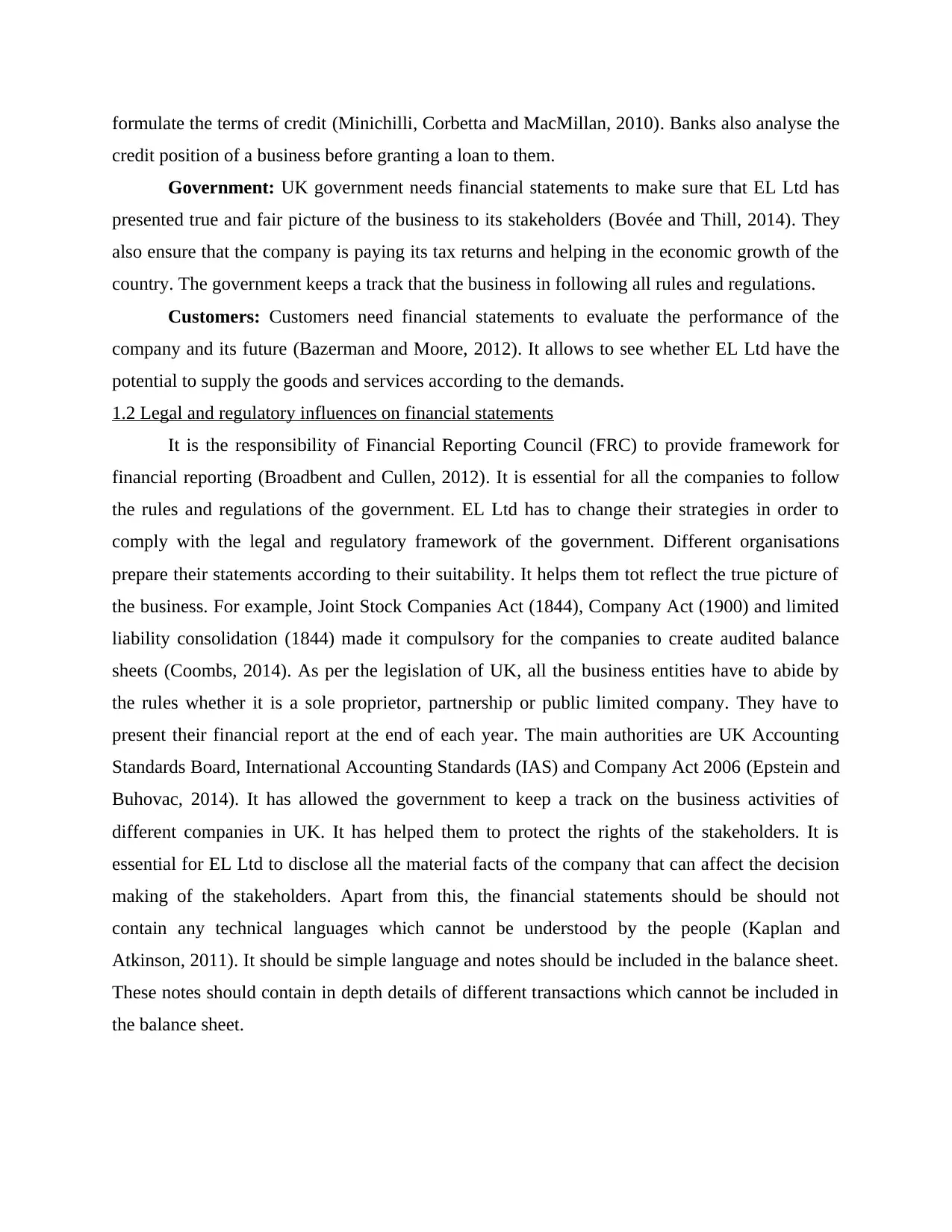
formulate the terms of credit (Minichilli, Corbetta and MacMillan, 2010). Banks also analyse the
credit position of a business before granting a loan to them.
Government: UK government needs financial statements to make sure that EL Ltd has
presented true and fair picture of the business to its stakeholders (Bovée and Thill, 2014). They
also ensure that the company is paying its tax returns and helping in the economic growth of the
country. The government keeps a track that the business in following all rules and regulations.
Customers: Customers need financial statements to evaluate the performance of the
company and its future (Bazerman and Moore, 2012). It allows to see whether EL Ltd have the
potential to supply the goods and services according to the demands.
1.2 Legal and regulatory influences on financial statements
It is the responsibility of Financial Reporting Council (FRC) to provide framework for
financial reporting (Broadbent and Cullen, 2012). It is essential for all the companies to follow
the rules and regulations of the government. EL Ltd has to change their strategies in order to
comply with the legal and regulatory framework of the government. Different organisations
prepare their statements according to their suitability. It helps them tot reflect the true picture of
the business. For example, Joint Stock Companies Act (1844), Company Act (1900) and limited
liability consolidation (1844) made it compulsory for the companies to create audited balance
sheets (Coombs, 2014). As per the legislation of UK, all the business entities have to abide by
the rules whether it is a sole proprietor, partnership or public limited company. They have to
present their financial report at the end of each year. The main authorities are UK Accounting
Standards Board, International Accounting Standards (IAS) and Company Act 2006 (Epstein and
Buhovac, 2014). It has allowed the government to keep a track on the business activities of
different companies in UK. It has helped them to protect the rights of the stakeholders. It is
essential for EL Ltd to disclose all the material facts of the company that can affect the decision
making of the stakeholders. Apart from this, the financial statements should be should not
contain any technical languages which cannot be understood by the people (Kaplan and
Atkinson, 2011). It should be simple language and notes should be included in the balance sheet.
These notes should contain in depth details of different transactions which cannot be included in
the balance sheet.
credit position of a business before granting a loan to them.
Government: UK government needs financial statements to make sure that EL Ltd has
presented true and fair picture of the business to its stakeholders (Bovée and Thill, 2014). They
also ensure that the company is paying its tax returns and helping in the economic growth of the
country. The government keeps a track that the business in following all rules and regulations.
Customers: Customers need financial statements to evaluate the performance of the
company and its future (Bazerman and Moore, 2012). It allows to see whether EL Ltd have the
potential to supply the goods and services according to the demands.
1.2 Legal and regulatory influences on financial statements
It is the responsibility of Financial Reporting Council (FRC) to provide framework for
financial reporting (Broadbent and Cullen, 2012). It is essential for all the companies to follow
the rules and regulations of the government. EL Ltd has to change their strategies in order to
comply with the legal and regulatory framework of the government. Different organisations
prepare their statements according to their suitability. It helps them tot reflect the true picture of
the business. For example, Joint Stock Companies Act (1844), Company Act (1900) and limited
liability consolidation (1844) made it compulsory for the companies to create audited balance
sheets (Coombs, 2014). As per the legislation of UK, all the business entities have to abide by
the rules whether it is a sole proprietor, partnership or public limited company. They have to
present their financial report at the end of each year. The main authorities are UK Accounting
Standards Board, International Accounting Standards (IAS) and Company Act 2006 (Epstein and
Buhovac, 2014). It has allowed the government to keep a track on the business activities of
different companies in UK. It has helped them to protect the rights of the stakeholders. It is
essential for EL Ltd to disclose all the material facts of the company that can affect the decision
making of the stakeholders. Apart from this, the financial statements should be should not
contain any technical languages which cannot be understood by the people (Kaplan and
Atkinson, 2011). It should be simple language and notes should be included in the balance sheet.
These notes should contain in depth details of different transactions which cannot be included in
the balance sheet.

1.3 Assess the implications for the users
Legal and regulatory framework of UK has significant implications of the stakeholders.
They can use the financial statements to assess the position and performance of EL Ltd. The
main aim of the government is to protect the interests of the consumers and other stakeholders
(Kaplan and Atkinson, 2011). But still many people believed that there are many loopholes in the
preparation of the financial reports. The financial reports of the company are very complicated.
Many companies have provided extremely detailed information which extends to more than 100
pages. Even though, all the material information have been presented in the report but it is
impossible for the users to understand it due to unimportant complexities (Ledgerwood, 2014).
Furthermore, the management of EL Ltd can opt for those accounting treatments that is in favour
of their business. It can distort the entire picture which can influence the decision making of the
people. There are certain rules and regulations which have to followed by the companies. The
overall impact on the users of the financial statements have been positive. It has allowed them to
rely on the financial reports while taking investments decisions (Lusardi, 2011). They can use
credit details, cash inflow and outflows for future decision making. The government also
analyses the statements of EL Ltd to see whether they have been working for the benefits of the
society or not. It gives them details for their income, profitability, liquidity, solvency and credit
worthiness. Financial Reporting Council (FRC) makes sure that all the companies follow the
regulations and prepare their statements accordingly (Madura, 2011). This protects the investors
and stakeholders from any unfair practices adopted by a business.
1.4 How different laws/ regulations are dealt with by accounting and reporting standards
Accounting and reporting standards are changed by the government according to the
requirements. These changes are made so as to improve transparency in the business activities of
various companies in UK. The Security and Exchange Commission has restricted instability of
stocks in the market because it ensures that generally accepted accounting principles are
followed (Ingram, LaForge and Williams, 2012). It is the responsibility of Financial Accounting
Standards Board (FASB) to form standards for the preparation of financial statements. It protects
the interest of the investors and shareholders. Furthermore, it acts as a shield for the investors
and protects them from frauds and concealment of facts. UK has Internal accounting standards
which was established to assist in comprehensive financial accounting reports. Government
Accounting Standards Board (GASB) has made guidelines which are mandatory to be followed
Legal and regulatory framework of UK has significant implications of the stakeholders.
They can use the financial statements to assess the position and performance of EL Ltd. The
main aim of the government is to protect the interests of the consumers and other stakeholders
(Kaplan and Atkinson, 2011). But still many people believed that there are many loopholes in the
preparation of the financial reports. The financial reports of the company are very complicated.
Many companies have provided extremely detailed information which extends to more than 100
pages. Even though, all the material information have been presented in the report but it is
impossible for the users to understand it due to unimportant complexities (Ledgerwood, 2014).
Furthermore, the management of EL Ltd can opt for those accounting treatments that is in favour
of their business. It can distort the entire picture which can influence the decision making of the
people. There are certain rules and regulations which have to followed by the companies. The
overall impact on the users of the financial statements have been positive. It has allowed them to
rely on the financial reports while taking investments decisions (Lusardi, 2011). They can use
credit details, cash inflow and outflows for future decision making. The government also
analyses the statements of EL Ltd to see whether they have been working for the benefits of the
society or not. It gives them details for their income, profitability, liquidity, solvency and credit
worthiness. Financial Reporting Council (FRC) makes sure that all the companies follow the
regulations and prepare their statements accordingly (Madura, 2011). This protects the investors
and stakeholders from any unfair practices adopted by a business.
1.4 How different laws/ regulations are dealt with by accounting and reporting standards
Accounting and reporting standards are changed by the government according to the
requirements. These changes are made so as to improve transparency in the business activities of
various companies in UK. The Security and Exchange Commission has restricted instability of
stocks in the market because it ensures that generally accepted accounting principles are
followed (Ingram, LaForge and Williams, 2012). It is the responsibility of Financial Accounting
Standards Board (FASB) to form standards for the preparation of financial statements. It protects
the interest of the investors and shareholders. Furthermore, it acts as a shield for the investors
and protects them from frauds and concealment of facts. UK has Internal accounting standards
which was established to assist in comprehensive financial accounting reports. Government
Accounting Standards Board (GASB) has made guidelines which are mandatory to be followed
⊘ This is a preview!⊘
Do you want full access?
Subscribe today to unlock all pages.

Trusted by 1+ million students worldwide
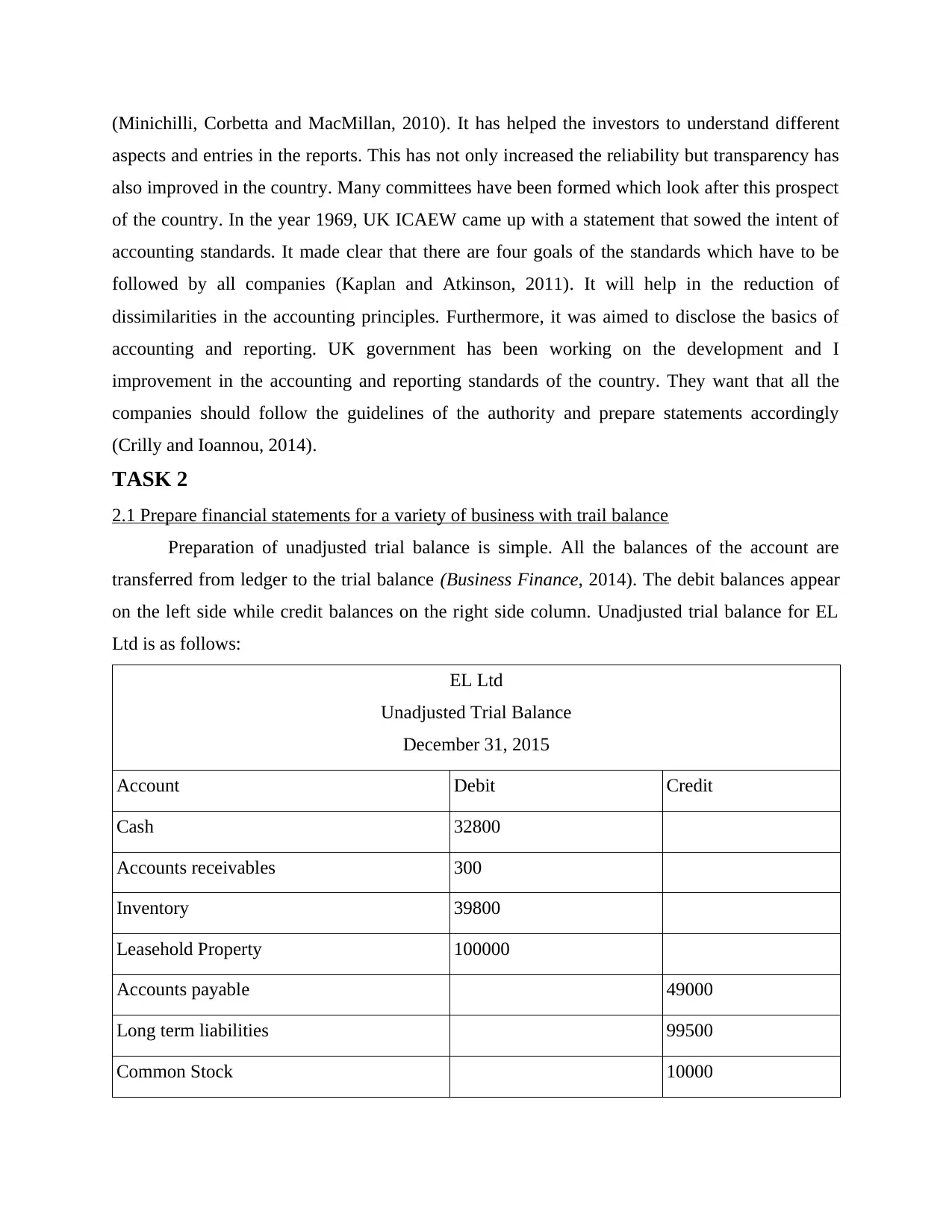
(Minichilli, Corbetta and MacMillan, 2010). It has helped the investors to understand different
aspects and entries in the reports. This has not only increased the reliability but transparency has
also improved in the country. Many committees have been formed which look after this prospect
of the country. In the year 1969, UK ICAEW came up with a statement that sowed the intent of
accounting standards. It made clear that there are four goals of the standards which have to be
followed by all companies (Kaplan and Atkinson, 2011). It will help in the reduction of
dissimilarities in the accounting principles. Furthermore, it was aimed to disclose the basics of
accounting and reporting. UK government has been working on the development and I
improvement in the accounting and reporting standards of the country. They want that all the
companies should follow the guidelines of the authority and prepare statements accordingly
(Crilly and Ioannou, 2014).
TASK 2
2.1 Prepare financial statements for a variety of business with trail balance
Preparation of unadjusted trial balance is simple. All the balances of the account are
transferred from ledger to the trial balance (Business Finance, 2014). The debit balances appear
on the left side while credit balances on the right side column. Unadjusted trial balance for EL
Ltd is as follows:
EL Ltd
Unadjusted Trial Balance
December 31, 2015
Account Debit Credit
Cash 32800
Accounts receivables 300
Inventory 39800
Leasehold Property 100000
Accounts payable 49000
Long term liabilities 99500
Common Stock 10000
aspects and entries in the reports. This has not only increased the reliability but transparency has
also improved in the country. Many committees have been formed which look after this prospect
of the country. In the year 1969, UK ICAEW came up with a statement that sowed the intent of
accounting standards. It made clear that there are four goals of the standards which have to be
followed by all companies (Kaplan and Atkinson, 2011). It will help in the reduction of
dissimilarities in the accounting principles. Furthermore, it was aimed to disclose the basics of
accounting and reporting. UK government has been working on the development and I
improvement in the accounting and reporting standards of the country. They want that all the
companies should follow the guidelines of the authority and prepare statements accordingly
(Crilly and Ioannou, 2014).
TASK 2
2.1 Prepare financial statements for a variety of business with trail balance
Preparation of unadjusted trial balance is simple. All the balances of the account are
transferred from ledger to the trial balance (Business Finance, 2014). The debit balances appear
on the left side while credit balances on the right side column. Unadjusted trial balance for EL
Ltd is as follows:
EL Ltd
Unadjusted Trial Balance
December 31, 2015
Account Debit Credit
Cash 32800
Accounts receivables 300
Inventory 39800
Leasehold Property 100000
Accounts payable 49000
Long term liabilities 99500
Common Stock 10000
Paraphrase This Document
Need a fresh take? Get an instant paraphrase of this document with our AI Paraphraser
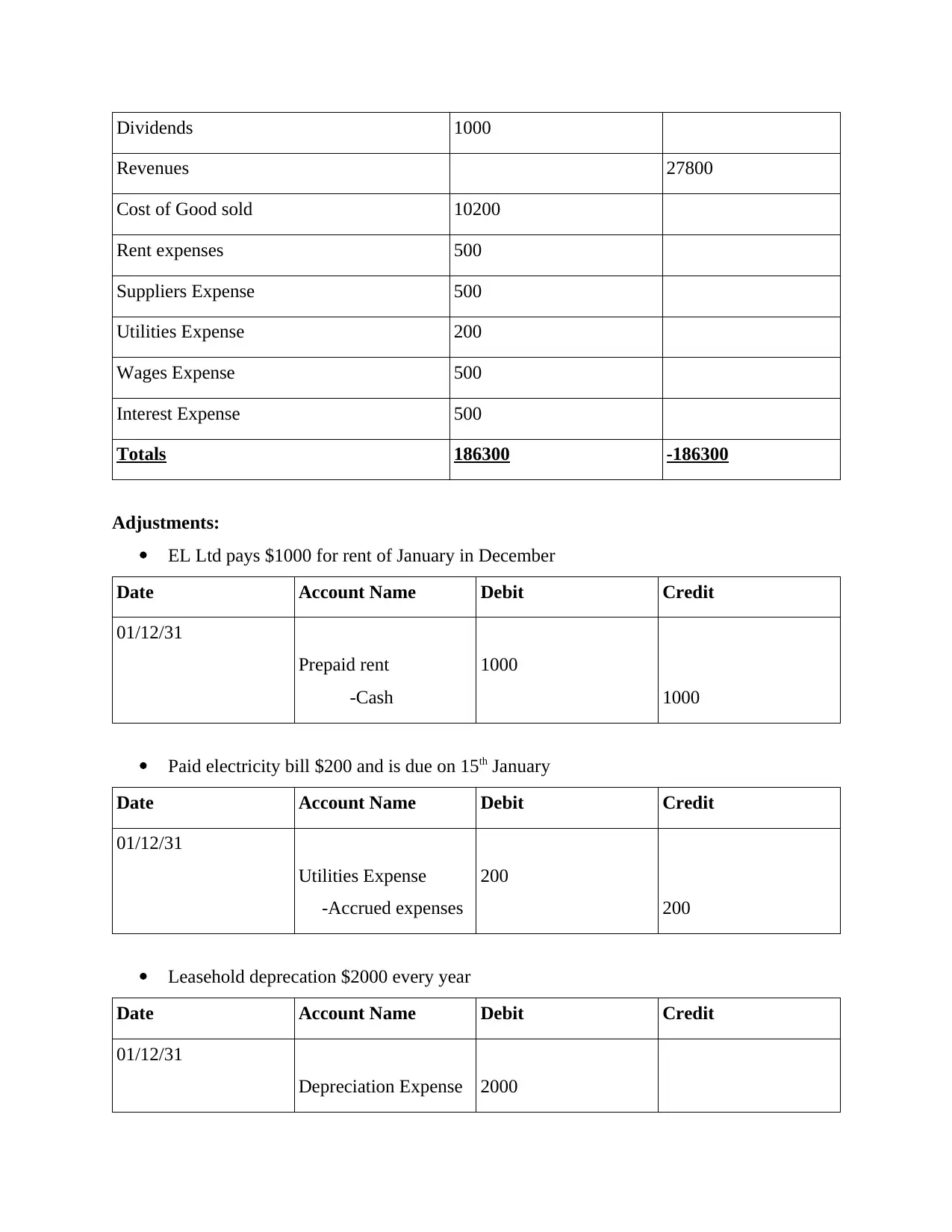
Dividends 1000
Revenues 27800
Cost of Good sold 10200
Rent expenses 500
Suppliers Expense 500
Utilities Expense 200
Wages Expense 500
Interest Expense 500
Totals 186300 -186300
Adjustments:
EL Ltd pays $1000 for rent of January in December
Date Account Name Debit Credit
01/12/31
Prepaid rent
-Cash
1000
1000
Paid electricity bill $200 and is due on 15th January
Date Account Name Debit Credit
01/12/31
Utilities Expense
-Accrued expenses
200
200
Leasehold deprecation $2000 every year
Date Account Name Debit Credit
01/12/31
Depreciation Expense 2000
Revenues 27800
Cost of Good sold 10200
Rent expenses 500
Suppliers Expense 500
Utilities Expense 200
Wages Expense 500
Interest Expense 500
Totals 186300 -186300
Adjustments:
EL Ltd pays $1000 for rent of January in December
Date Account Name Debit Credit
01/12/31
Prepaid rent
-Cash
1000
1000
Paid electricity bill $200 and is due on 15th January
Date Account Name Debit Credit
01/12/31
Utilities Expense
-Accrued expenses
200
200
Leasehold deprecation $2000 every year
Date Account Name Debit Credit
01/12/31
Depreciation Expense 2000
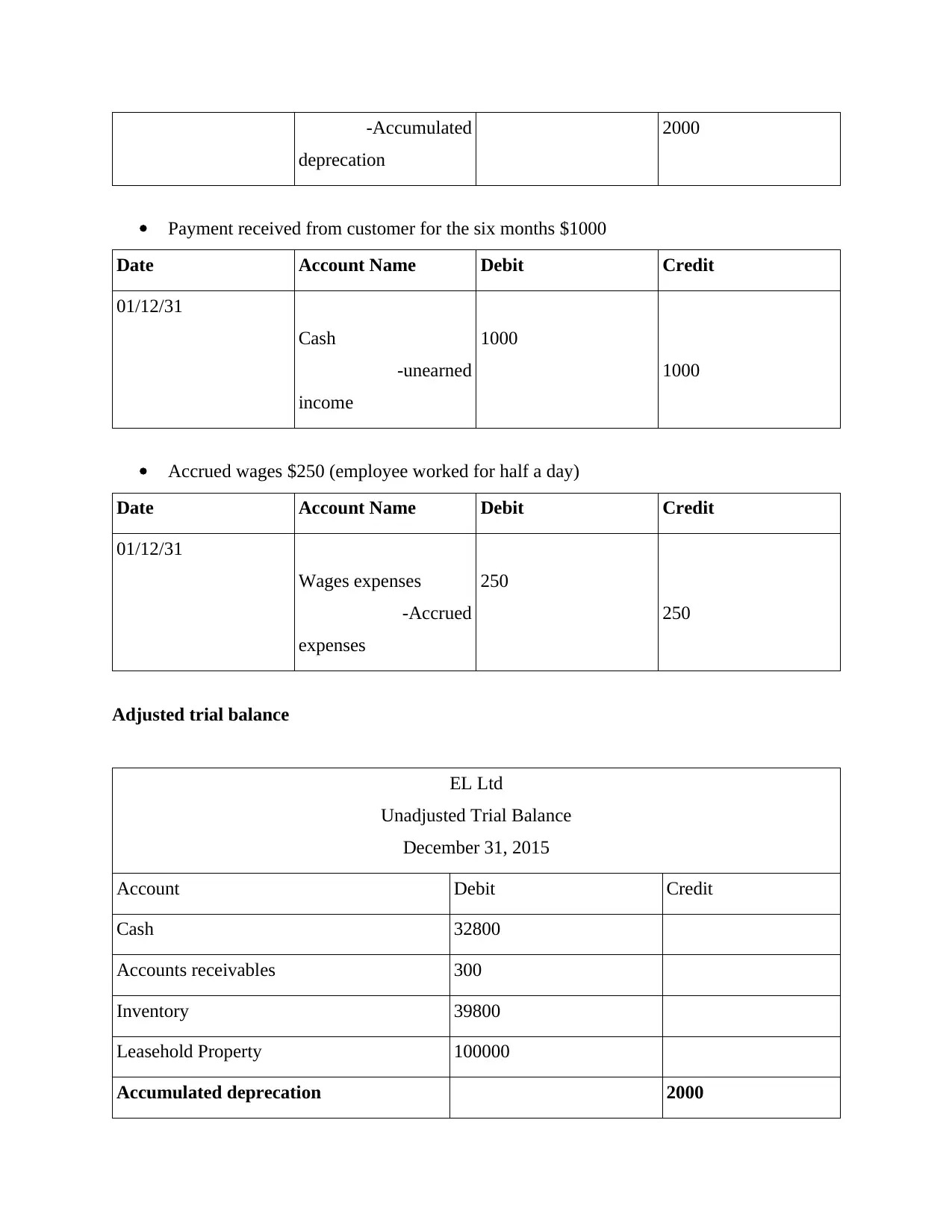
-Accumulated
deprecation
2000
Payment received from customer for the six months $1000
Date Account Name Debit Credit
01/12/31
Cash
-unearned
income
1000
1000
Accrued wages $250 (employee worked for half a day)
Date Account Name Debit Credit
01/12/31
Wages expenses
-Accrued
expenses
250
250
Adjusted trial balance
EL Ltd
Unadjusted Trial Balance
December 31, 2015
Account Debit Credit
Cash 32800
Accounts receivables 300
Inventory 39800
Leasehold Property 100000
Accumulated deprecation 2000
deprecation
2000
Payment received from customer for the six months $1000
Date Account Name Debit Credit
01/12/31
Cash
-unearned
income
1000
1000
Accrued wages $250 (employee worked for half a day)
Date Account Name Debit Credit
01/12/31
Wages expenses
-Accrued
expenses
250
250
Adjusted trial balance
EL Ltd
Unadjusted Trial Balance
December 31, 2015
Account Debit Credit
Cash 32800
Accounts receivables 300
Inventory 39800
Leasehold Property 100000
Accumulated deprecation 2000
⊘ This is a preview!⊘
Do you want full access?
Subscribe today to unlock all pages.

Trusted by 1+ million students worldwide
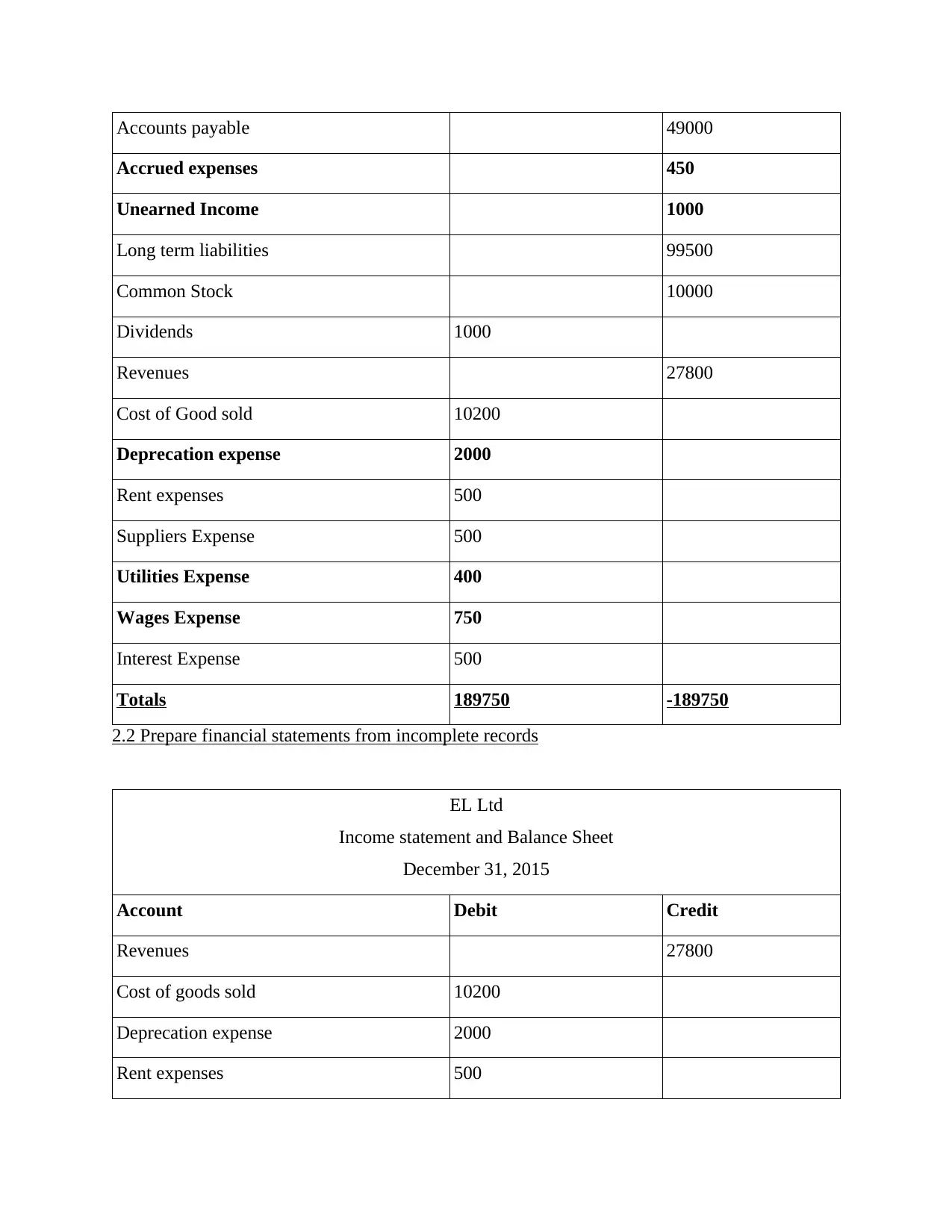
Accounts payable 49000
Accrued expenses 450
Unearned Income 1000
Long term liabilities 99500
Common Stock 10000
Dividends 1000
Revenues 27800
Cost of Good sold 10200
Deprecation expense 2000
Rent expenses 500
Suppliers Expense 500
Utilities Expense 400
Wages Expense 750
Interest Expense 500
Totals 189750 -189750
2.2 Prepare financial statements from incomplete records
EL Ltd
Income statement and Balance Sheet
December 31, 2015
Account Debit Credit
Revenues 27800
Cost of goods sold 10200
Deprecation expense 2000
Rent expenses 500
Accrued expenses 450
Unearned Income 1000
Long term liabilities 99500
Common Stock 10000
Dividends 1000
Revenues 27800
Cost of Good sold 10200
Deprecation expense 2000
Rent expenses 500
Suppliers Expense 500
Utilities Expense 400
Wages Expense 750
Interest Expense 500
Totals 189750 -189750
2.2 Prepare financial statements from incomplete records
EL Ltd
Income statement and Balance Sheet
December 31, 2015
Account Debit Credit
Revenues 27800
Cost of goods sold 10200
Deprecation expense 2000
Rent expenses 500
Paraphrase This Document
Need a fresh take? Get an instant paraphrase of this document with our AI Paraphraser
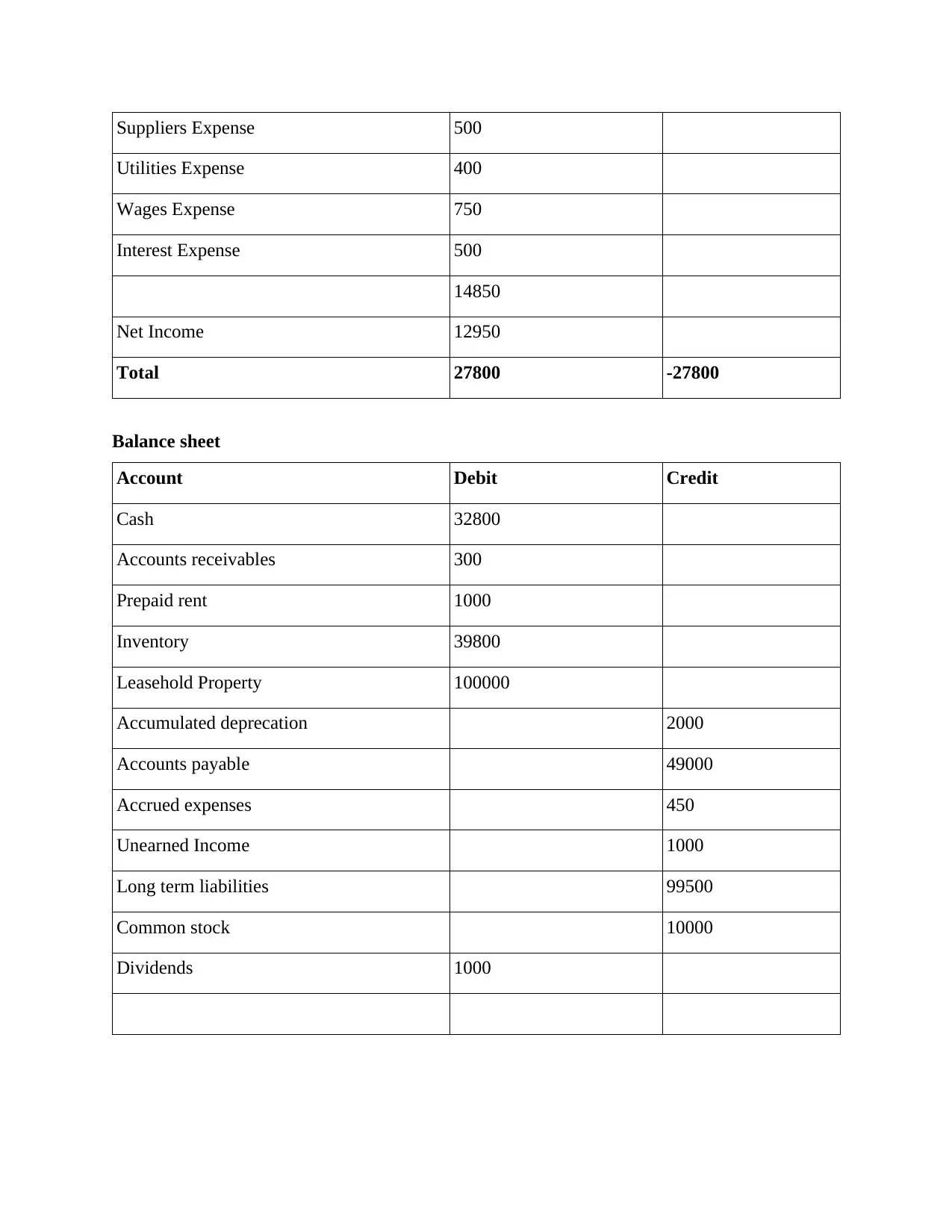
Suppliers Expense 500
Utilities Expense 400
Wages Expense 750
Interest Expense 500
14850
Net Income 12950
Total 27800 -27800
Balance sheet
Account Debit Credit
Cash 32800
Accounts receivables 300
Prepaid rent 1000
Inventory 39800
Leasehold Property 100000
Accumulated deprecation 2000
Accounts payable 49000
Accrued expenses 450
Unearned Income 1000
Long term liabilities 99500
Common stock 10000
Dividends 1000
Utilities Expense 400
Wages Expense 750
Interest Expense 500
14850
Net Income 12950
Total 27800 -27800
Balance sheet
Account Debit Credit
Cash 32800
Accounts receivables 300
Prepaid rent 1000
Inventory 39800
Leasehold Property 100000
Accumulated deprecation 2000
Accounts payable 49000
Accrued expenses 450
Unearned Income 1000
Long term liabilities 99500
Common stock 10000
Dividends 1000

2.3 Prepare a consolidated balance sheet and profit and loss statement
Consolidated Balance Sheet
Assets 2015
Cash 14842
Financial assets 7268
Investments 509493
Loans and advances 117630
Financial assets 105873
Reinsurance assets 14843
Deferred acquisition 25234
Deferred tax assets 1394
Other assets 38813
Non current assets 109
Intangible assets 13443
Liabilities and equity 2015
Financial liabilities 9207
Liabilities to bank 25531
Unearned premium 20660
Reserves for loss 72003
Reserves for insurance 486222
Financial liabilities for unit linked contracts 105873
Deferred tax liability 4003
Other liability 38686
liability for disposal group 18
Consolidated Balance Sheet
Assets 2015
Cash 14842
Financial assets 7268
Investments 509493
Loans and advances 117630
Financial assets 105873
Reinsurance assets 14843
Deferred acquisition 25234
Deferred tax assets 1394
Other assets 38813
Non current assets 109
Intangible assets 13443
Liabilities and equity 2015
Financial liabilities 9207
Liabilities to bank 25531
Unearned premium 20660
Reserves for loss 72003
Reserves for insurance 486222
Financial liabilities for unit linked contracts 105873
Deferred tax liability 4003
Other liability 38686
liability for disposal group 18
⊘ This is a preview!⊘
Do you want full access?
Subscribe today to unlock all pages.

Trusted by 1+ million students worldwide
1 out of 21
Related Documents
Your All-in-One AI-Powered Toolkit for Academic Success.
+13062052269
info@desklib.com
Available 24*7 on WhatsApp / Email
![[object Object]](/_next/static/media/star-bottom.7253800d.svg)
Unlock your academic potential
Copyright © 2020–2025 A2Z Services. All Rights Reserved. Developed and managed by ZUCOL.





